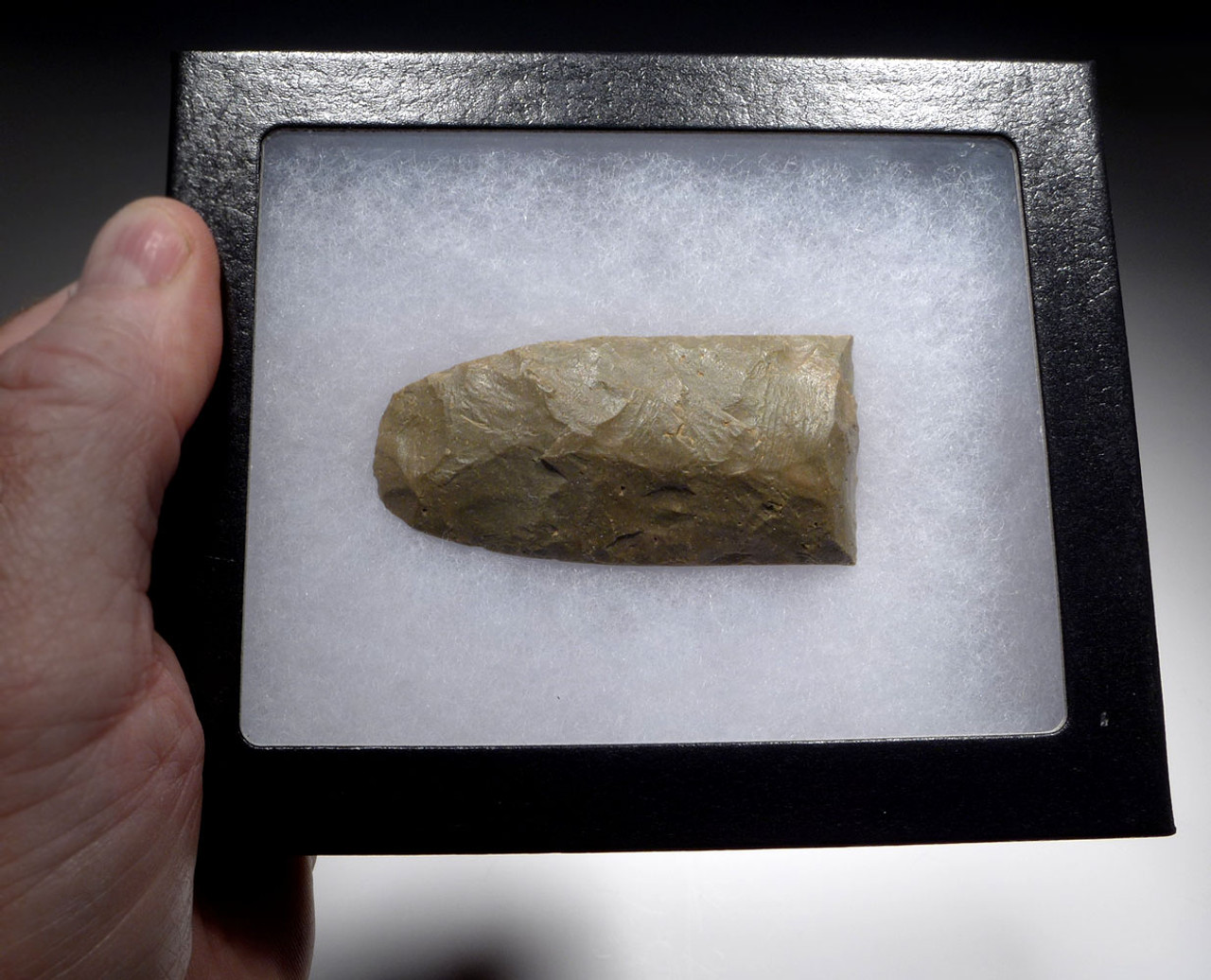Product Description
SEE MORE AFRICAN NEOLITHIC TOOLS AND ARTIFACTS
On a dinosaur fossil-hunting expedition in 2000 by a team of scientific explorers led by Paul Sereno, a paleodune and ancient lakebed site was discovered that yielded over 200 ancient burials of Kiffian and Tenerian people. The scientific findings showed that this area was once a humid lake region that was home to a hunter-fisher-gatherer people. The area became known as the "Green Sahara" for its once fertile and habitable landscape. Noted paleontologist, Dr. Paul Sereno, famous for other Saharan dinosaur discoveries, shot into the archaeological spotlight with his discovery of the ancient lakebed cemetery at Gobero in Niger in the year 2000. Interred in the many burials were numerous stone tools, ceramics, shells, beads and bone harpoons typical for the lifestyle of these ancient people of the Green Sahara. This exceptional AUTHENTIC artifact is similar to the specimens found at Gobero. It comes from the same period and Tenerian Neolithic Culture of that famous discovery.
This is a ground and knapped CELT AXE HEAD. It is made of green jasper, the famous colorful lithic of the Tenerian African Neolithic culture. The process of its manufacture would have first required a blank to be ground out of the stone. After that, the surface and chopping end was flaked to refine its shape and add a sharp edge to the end. In many cases, these axes are either fully ground and polished without any flaking or, flaked over the entire surface after grinding the blank. In this unique specimen, one side has been fully flaked while the other side was left as a purely ground and polished smooth. This is not an incomplete manufactured artifact - the design allowed a simply made axe yet, this the addition of the flaking on one side to create a steep, chopping end of durability.
Superbly crafted Neolithic green jasper stone tools like this are so unique in archaeology that they can be identified to this rare African Neolithic culture merely by their appearance - no other ancient or prehistoric stone tool culture in the world has ever matched the workmanship and beauty of these artifacts. The stone type alone, is immediately recognizable as coming from only one place on the planet - the Tenere region of the south central Sahara Desert. This is an exceptional example of these "mascot" objects of this Neolithic society. With its reduced size like the small axe heads used in Indian war tomahawks, an axe of this type would have been an effective striking weapon in combat. By this time in the Sahara, large trees were non-existent and an axe of this diminutive size would have been useless in conventional tree-cutting tasks. The smaller size of this axe was preferred when employed in a close combat weapon.
This axe head features SUPERB flaking throughout to achieve excellent form and ideal chopping end. The entire surface displays an ancient 'desert varnish' patina - a smooth, wind-worn surface from long-term desert exposure. Original sediment from the site is still embedded in the microscopic flake scars - a feature ONLY seen in AUTHENTIC examples. If you want the pinnacle of craftsmanship from the Tenerian Neolithic stone tool culture, then THIS is a MUST HAVE, important and rare object to have in your collection. The site where these artifacts were once found has been completely picked clean by modern nomads.
We are very fortunate to have acquired an old French collection formed many decades ago, of a former safari guide to the region. Nevertheless, we have a very limited amount and once sold, we will never be able to replace them. Objects from the Tenerian African Neolithic culture are so rare that not even most major museums have a single object in their collection.
HISTORY
The Earth has been warming and cooling for millions of year, well long before humans were on the planet. One of the most dramatic examples of climatic change in the last 10,000 years is the desiccation of what is now the Sahara desert. Prior to as recent as 3000 B.C., the South Central Sahara region in Africa was a humid lake savanna. It was home to a thriving culture of ancient humans known as the Tenerians and before them, the Kiffians. The occupation of this area by these two peoples occurred continuously from around 7700 B.C. to the drying of the Sahara in 2500 B.C..
In the final Pleistocene and early Holocene Periods around 10,000 years ago, the South Central Sahara Desert was once a highly favorable environment for hunters, gatherers and pastoralists. Freshwater lakes existed between the dunes in what is now the Tenere region, Lake Chad was eight times its current size, the highlands supported Mediterranean forest trees, and a diverse variety of both large and small fauna flourished there. The slow drying out process of the Sahara, began 7,000 years ago and ended 4500 years ago resulting in the barren conditions that exist to this day. As we progress through time from the end of the Pleistocene towards the end of the Neolithic Period there, we see humans relying more on meat from raised animals as opposed to hunted animals that once roamed wild in the formerly Green Sahara.
 US DOLLAR
US DOLLAR
 EURO
EURO
 AUSTRALIAN DOLLAR
AUSTRALIAN DOLLAR
 CANADIAN DOLLAR
CANADIAN DOLLAR
 POUND STERLING
POUND STERLING


















